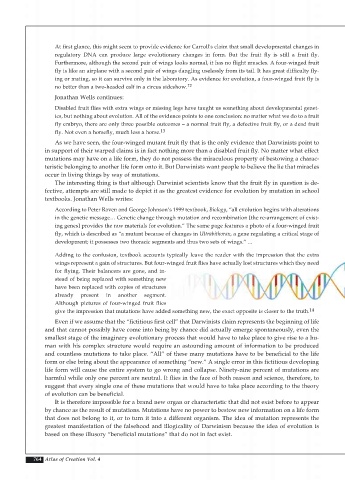Page 766 - Atlas of Creation Volume 4
P. 766
At first glance, this might seem to provide evidence for Carroll's claim that small developmental changes in
regulatory DNA can produce large evolutionary changes in form. But the fruit fly is still a fruit fly.
Furthermore, although the second pair of wings looks normal, it has no flight muscles. A four-winged fruit
fly is like an airplane with a second pair of wings dangling uselessly from its tail. It has great difficulty fly-
ing or mating, so it can survive only in the laboratory. As evidence for evolution, a four-winged fruit fly is
no better than a two-headed calf in a circus sideshow. 12
Jonathan Wells continues:
Disabled fruit flies with extra wings or missing legs have taught us something about developmental genet-
ics, but nothing about evolution. All of the evidence points to one conclusion: no matter what we do to a fruit
fly embryo, there are only three possible outcomes – a normal fruit fly, a defective fruit fly, or a dead fruit
fly. Not even a horsefly, much less a horse. 13
As we have seen, the four-winged mutant fruit fly that is the only evidence that Darwinists point to
in support of their warped claims is in fact nothing more than a disabled fruit fly. No matter what effect
mutations may have on a life form, they do not possess the miraculous property of bestowing a charac-
teristic belonging to another life form onto it. But Darwinists want people to believe the lie that miracles
occur in living things by way of mutations.
The interesting thing is that although Darwinist scientists know that the fruit fly in question is de-
fective, attempts are still made to depict it as the greatest evidence for evolution by mutation in school
textbooks. Jonathan Wells writes:
According to Peter Raven and George Johnson’s 1999 textbook, Biology, “all evolution begins with alterations
in the genetic message… Genetic change through mutation and recombination [the re-arrangement of exist-
ing genes] provides the raw materials for evolution.” The same page features a photo of a four-winged fruit
fly, which is described as “a mutant because of changes in Ultrabithorax, a gene regulating a critical stage of
development; it possesses two thoracic segments and thus two sets of wings.” ...
Adding to the confusion, textbook accounts typically leave the reader with the impression that the extra
wings represent a gain of structures. But four-winged fruit flies have actually lost structures which they need
for flying. Their balancers are gone, and in-
stead of being replaced with something new
have been replaced with copies of structures
already present in another segment.
Although pictures of four-winged fruit flies
give the impression that mutations have added something new, the exact opposite is closer to the truth. 14
Even if we assume that the “fictitious first cell” that Darwinists claim represents the beginning of life
and that cannot possibly have come into being by chance did actually emerge spontaneously, even the
smallest stage of the imaginary evolutionary process that would have to take place to give rise to a hu-
man with his complex structure would require an astounding amount of information to be produced
and countless mutations to take place. “All” of these many mutations have to be beneficial to the life
form or else bring about the appearance of something “new.” A single error in this fictitious developing
life form will cause the entire system to go wrong and collapse. Ninety-nine percent of mutations are
harmful while only one percent are neutral. It flies in the face of both reason and science, therefore, to
suggest that every single one of these mutations that would have to take place according to the theory
of evolution can be beneficial.
It is therefore impossible for a brand new organ or characteristic that did not exist before to appear
by chance as the result of mutations. Mutations have no power to bestow new information on a life form
that does not belong to it, or to turn it into a different organism. The idea of mutation represents the
greatest manifestation of the falsehood and illogicality of Darwinism because the idea of evolution is
based on these illusory “beneficial mutations” that do not in fact exist.
764 Atlas of Creation Vol. 4

